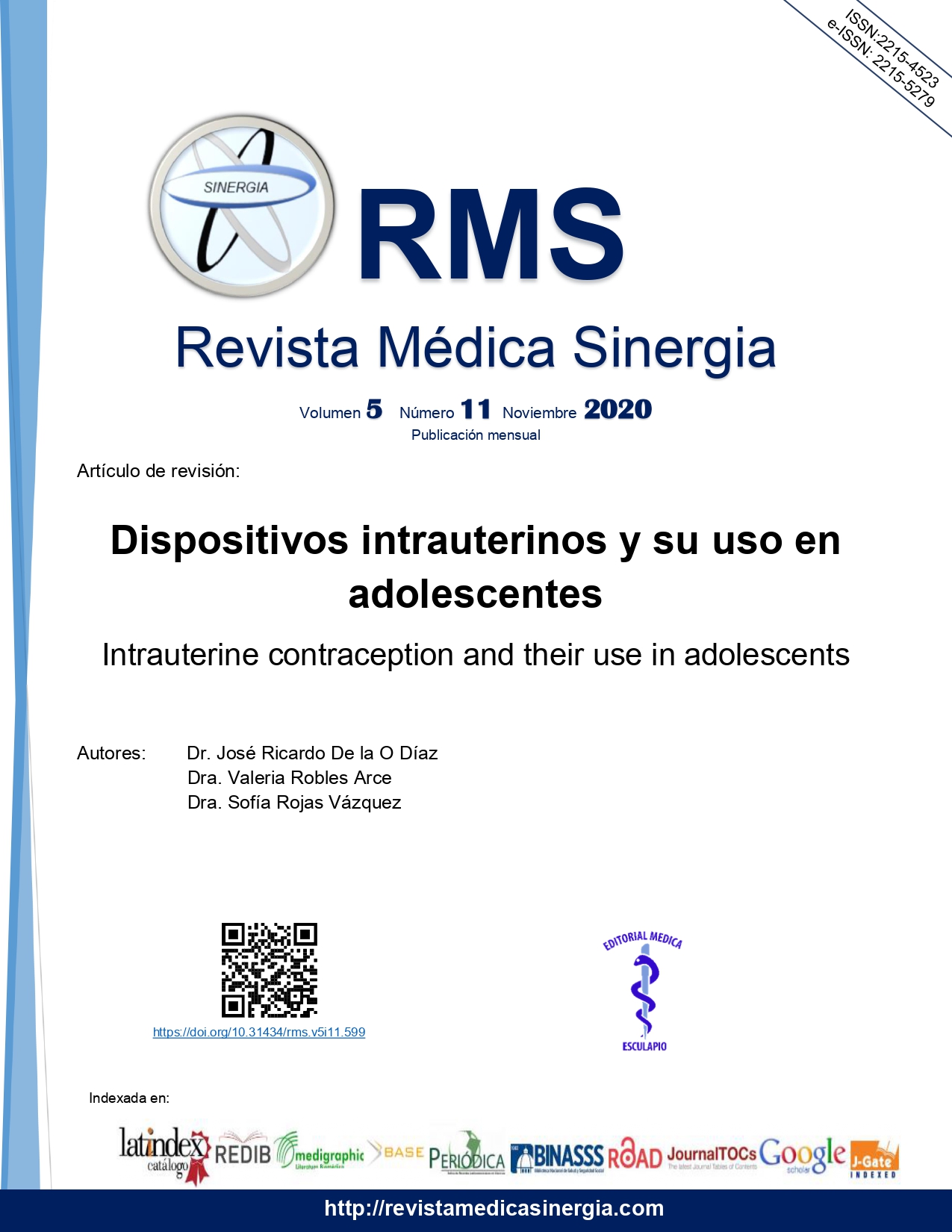Abstract
for this population, including uterine devices, has been widely studied. For many years, doctors have refrained from recommending this method of contraception based on myths and lack of knowledge of these methods. However, IUDs have been found to be highly reliable and safe and are recommended by the American The population of adolescent women has become a vulnerable group in terms of unwanted pregnancies. Herein lies the importance of contraceptive use in this population group. The use of long-term reversible contraceptives Academy of Pediatrics and the American College of Obstetricians and Gynecologists as first-line contraceptive methods for adolescents, making it necessary to educate patients and train health workers for the benefit of this group of women.
Keywords
References
Apter D. International Perspectives: IUDs and Adolescents. Journal of Pediatric and Adolescent Gynecology. 2019;32(5):S36-S42. https://doi.org/10.1016/j.jpag.2019.04.009
Apter . Contraception options: Aspects unique to adolescent and young adult. Best Practice & Research Clinical Obstetrics & Gynaecology. 2018;48:115-127. https://doi.org/10.1016/j.bpobgyn.2017.09.010
Whaley N, Burke A. Intrauterine Contraception. Women's Health. 2015;11(6):759-767. https://doi.org/10.2217/whe.15.77
Francis J, Gold M. Long-Acting Reversible Contraception for Adolescents. JAMA Pediatrics. 2017;171(7):694. https://doi.org/10.1001/jamapediatrics.2017.0598
Usinger K, Gola S, Weis M, Smaldone A. Intrauterine Contraception Continuation in Adolescents and Young Women: A Systematic Review. Journal of Pediatric and Adolescent Gynecology. 2016;29(6):659-667. https://doi.org/10.1016/j.jpag.2016.06.007
Patseadou M, Michala L. Usage of the levonorgestrel-releasing intrauterine system (LNG-IUS) in adolescence: what is the evidence so far?. Archives of Gynecology and Obstetrics. 2016;295(3):529-541. https://doi.org/10.1007/s00404-016-4261-0
Jatlaoui T, Riley H, Curtis K. The safety of intrauterine devices among young women: a systematic review. Contraception. 2017;95(1):17-39. https://doi.org/10.1016/j.contraception.2016.10.006
Sabbioni L, Petraglia F, Luisi S. Non-contraceptive benefits of intrauterine levonorgestrel administration: why not?. Gynecological Endocrinology. 2017;33(11):822-829.https://doi.org/10.1080/09513590.2017.1334198
Creinin M, Hsia J. Intrauterine Contraception. Seminars in Reproductive Medicine. 2016;34(03):175-182. https://doi.org/10.1055/s-0036-1571438
Allen S, Barlow E. Long-Acting Reversible Contraception. Pediatric Clinics of North America. 2017;64(2):359-369. https://doi.org/10.1016/j.pcl.2016.11.014
Diedrich J, Klein D, Peipert J. Long-acting reversible contraception in adolescents: a systematic review and meta-analysis. American Journal of Obstetrics and Gynecology. 2017;216(4):364.e1-364.e12.rencias. https://doi.org/10.1016/j.ajog.2016.12.024
Raidoo S, Kaneshiro B. Providing Contraception to Adolescents. Obstetrics and Gynecology Clinics of North America. 2015;42(4):631-645. https://doi.org/10.1016/j.ogc.2015.08.004
Godfrey E. Helping Clinicians Prevent Pregnancy among Sexually Active Adolescents: U.S. Medical Eligibility Criteria for Contraceptive Use and U.S. Selected Practice Recommendations for Contraceptive Use. Journal of Pediatric and Adolescent Gynecology. 2015;28(4):209-214. https://doi.org/10.1016/j.jpag.2014.08.006
Bahamondes L, Valeria Bahamondes M, Shulman L. Non-contraceptive benefits of hormonal and intrauterine reversible contraceptive methods. Human Reproduction Update. 2015;21(5):640-651. https://doi.org/10.1093/humupd/dmv023
Raidoo S, Kaneshiro B. Contraception counseling for adolescents. Current Opinion in Obstetrics and Gynecology. 2017;29(5):310-315. https://doi.org/10.1097/GCO.0000000000000390

This work is licensed under a Creative Commons Attribution-NonCommercial 4.0 International License.
Copyright (c) 2020 Array


